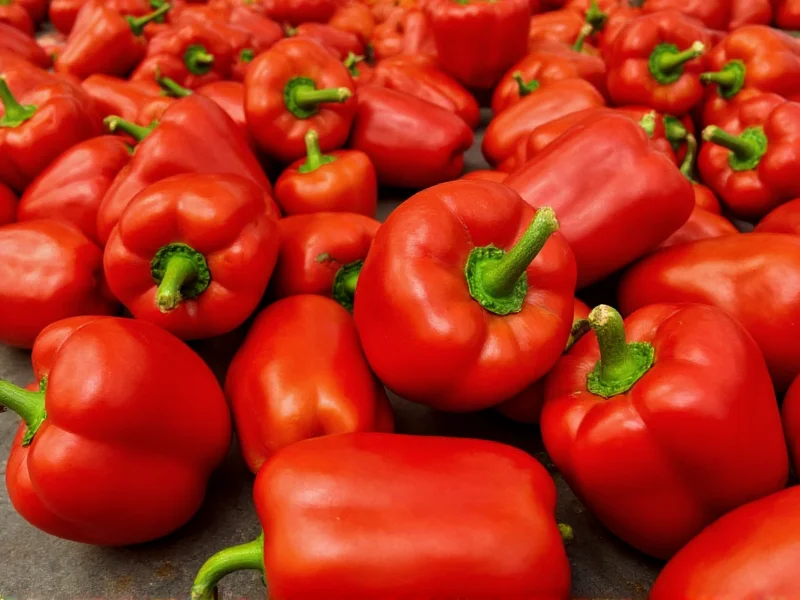Paprika isn't just a single spice but a spectrum of ground pepper products with distinct characteristics shaped by botanical, geographical, and processing factors. Understanding what makes paprika requires examining its botanical origins, production methods, and chemical composition that create its signature color, flavor, and culinary properties.
Botanical Origins of Paprika
Paprika originates from specific varieties of Capsicum annuum, the same species that includes bell peppers and many chili peppers. Unlike cayenne or other hot peppers that come from Capsicum frutescens or Capsicum chinense, paprika peppers have been selectively bred over centuries for particular qualities.
The key factor in what makes paprika special is the careful selection of pepper varieties. Hungarian paprika typically comes from Kurri, Komáromi, and Esztergom varieties, while Spanish paprika often uses Óná and Bola peppers. These varieties contain high concentrations of carotenoids but relatively low levels of capsaicin compared to hotter chili varieties.
Production Process: From Pepper to Powder
The journey from fresh pepper to finished paprika involves several critical steps that directly impact its final characteristics:
| Production Stage | Key Considerations | Impact on Final Product |
|---|---|---|
| Harvesting | Peppers harvested at full maturity | Higher sugar and pigment content |
| Drying | Temperature-controlled air drying | Preserves color compounds; prevents mold |
| Processing | Seeds and placenta removed before grinding | Reduces heat level; improves color |
| Grinding | Stone grinding at low temperatures | Maintains volatile flavor compounds |
What makes smoked paprika different is an additional step where peppers are slowly smoked over oak or holm oak wood for several days. This traditional Spanish method (dehesa smoking) imparts distinctive phenolic compounds that create that characteristic smoky flavor profile.
Chemical Composition: The Science Behind Paprika
The distinctive qualities of paprika come from its complex chemical makeup:
Color Compounds
What makes paprika red are carotenoid pigments, primarily:
- Capsanthin (50-70% of total carotenoids) - responsible for the deep red hue
- Capsorubin - contributes to orange-red tones
- Beta-carotene - provides yellow-orange undertones
These compounds are fat-soluble, which explains why paprika's color releases best when cooked with oils. The concentration of these pigments varies based on growing conditions, with optimal sunlight exposure increasing carotenoid production.
Flavor Components
What makes paprika taste the way it does involves multiple compounds:
- Capsaicinoids - present in much lower concentrations than in hot chilies (0.01-1.0% vs 5-15% in cayenne)
- Volatile oils - including piperine and various terpenes that create complex aroma notes
- Sugars - bell pepper varieties used for sweet paprika contain higher sugar content (6-8%)
Different Types of Paprika and What Makes Them Unique
Understanding what makes paprika varieties different requires examining regional production methods:
Sweet Paprika
Made from sweet pepper varieties with minimal capsaicin. Hungarian sweet paprika (like Edény) contains less than 0.1% capsaicin, making it ideal for adding color without heat. What makes sweet paprika special is its higher sugar content and balanced carotenoid profile.
Hot Paprika
Contains higher concentrations of capsaicin (0.5-1.0%) from specific hot pepper varieties. What makes hot paprika different is the inclusion of some placenta tissue during processing, which contains the highest concentration of capsaicin in the pepper.
Smoked Paprika (Pimentón)
What makes smoked paprika unique is the traditional smoking process over oak wood, which introduces guaiacol and other phenolic compounds. Spanish smoked paprika comes in three varieties: dulce (sweet), agridulce (bittersweet), and picante (hot).
How Paprika Differs From Similar Spices
Many people wonder what makes paprika different from chili powder or cayenne. While all come from peppers, key distinctions exist:
- Paprika vs. Chili Powder: American chili powder often contains additional spices like cumin and garlic, while pure paprika contains only ground peppers
- Paprika vs. Cayenne: Cayenne comes from hotter Capsicum varieties with 5-15 times more capsaicin than most paprikas
- Paprika vs. Red Pepper Flakes: Paprika is a fine powder with more consistent flavor release, while flakes provide uneven heat distribution
Maximizing Paprika's Qualities in Cooking
To best utilize what makes paprika special in your cooking:
- Add sweet paprika early in cooking to develop flavor complexity
- Add smoked paprika toward the end of cooking to preserve delicate smoke compounds
- Bloom paprika in oil first to release fat-soluble color compounds
- Store in airtight containers away from light to preserve carotenoids
Frequently Asked Questions
What gives paprika its red color?
Paprika's vibrant red color comes primarily from carotenoid pigments, especially capsanthin (50-70% of total carotenoids) and capsorubin. These compounds are concentrated in the pepper's skin and are preserved through careful drying and grinding processes.
How is paprika made from peppers?
Paprika is made by harvesting fully mature peppers, removing stems and seeds, air-drying at controlled temperatures (typically 25-30°C), and then stone-grinding the dried peppers into a fine powder. For smoked paprika, peppers are slowly smoked over oak wood before grinding.
What's the difference between sweet and hot paprika?
The difference lies in capsaicin content and processing. Sweet paprika comes from sweet pepper varieties with minimal capsaicin (less than 0.1%), while hot paprika contains higher capsaicin levels (0.5-1.0%) from hotter pepper varieties. Hot paprika often includes some of the pepper's placenta, which contains the highest concentration of capsaicin.
Why does paprika lose its color over time?
Paprika's color fades due to degradation of carotenoid pigments when exposed to light, heat, and oxygen. Proper storage in airtight, opaque containers in a cool, dark place can preserve color for 6-12 months. The fat-soluble nature of these pigments means they're more stable when used in oil-based preparations.
What makes smoked paprika different from regular paprika?
Smoked paprika undergoes a traditional smoking process where peppers are slowly dried over oak or holm oak wood for several days. This introduces phenolic compounds like guaiacol that create its distinctive smoky flavor, setting it apart from regular air-dried paprika which has a cleaner, brighter pepper flavor.











 浙公网安备
33010002000092号
浙公网安备
33010002000092号 浙B2-20120091-4
浙B2-20120091-4